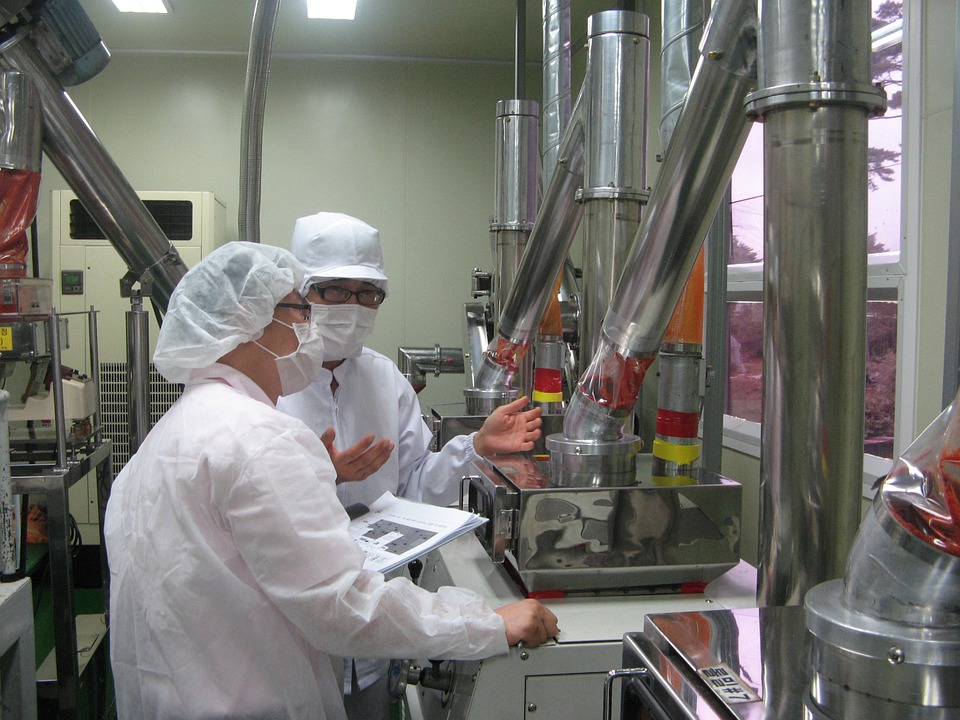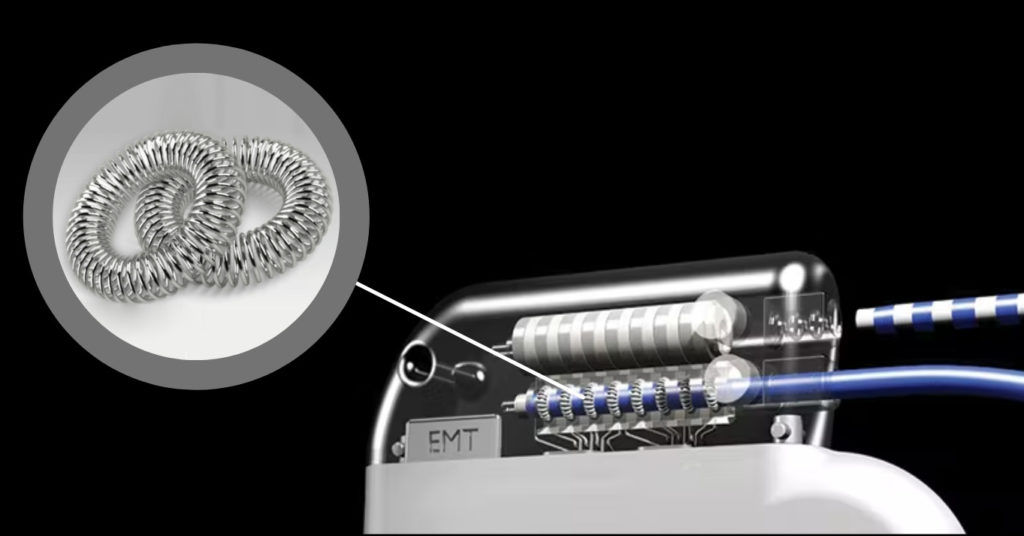The ability of cryogenic seals to maintain integrity is often critical not just for the processes involved but for the safety of humans, other equipment, and the environment. Seal failure could lead to expensive damage, hefty lawsuits, and even loss of life. Finding reliable solutions that can handle cryogenic temperatures and the pressures involved is challenging but not impossible.
PTFE + Spring-Energized Seals: A Reliable Solution for Food and Pharmaceutical Processing
The primary challenge in specifying a seal is finding a solution that achieves consistent seal integrity for the operating conditions involved. However, when food or pharmaceuticals are involved, additional challenges arise — and can be met using PTFE spring-energized seals.
Design Concerns for Food and Pharmaceutical Seals
There are a number of critical design considerations involved with any type of sealing application, such as operating temperature, pressure, velocity, wear rate, friction, and chemical compatibility.
When food, dairy, or pharmaceuticals are involved, however, there are additional criteria. The first of these is finding a material that is compliant with relevant standards. In the United States, the main standard is the Food and Drug Administration standard FDA 21 CFR Part 177. This standard covers indirect food additives and thus applies to seals. For a material to be considered FDA compliant, it must be safe for human consumption and chemically inert.
Another potential challenge related to food and pharmaceuticals is MRO (Maintenance, Repair, and Operations): 3-A (Dairy and Milk) sanitary standards 18-03 for rubber materials and 20-27 for polymers, as well as NSF (National Sanitation Foundation) sanitary practice standards such as NSF/ANSI 2-2021. Such standards and practices deal with CIP (Clean-In-Place) and SIP (Sanitize-In-Place). CIP/SIP processes often involve …
- Extremely high temperatures, which can affect seal integrity and dimensional stability if the right material is not selected
- Exposure to hot water and steam, which can prove problematic for materials that have a significant water absorption rate
- Aggressive media, which can permanently compromise seal integrity if the jacket material is not compatible with the cleaning media
Wear resistance is also a critical factor: as the seal begins to wear, its particles become a potential source of contamination. This is particularly problematic when food, dairy, beverage, or pharmaceuticals are involved because those wear particles will likely be ingested. The seal material must, therefore, have a low rate of wear and be safe for occasional ingestion.
Extreme temperatures are often involved and can range from cryogenic (where elastomers and polymers may develop brittle behavior) to extreme heat (where the strength and stiffness of the seal material may be significantly reduced). Seal materials for food and pharmaceutical applications may experience both temperature extremes during regular operation, which may involve the CIP/SIP procedures discussed earlier.
Lubrication is also a major design choice for food and pharmaceutical sealing solutions. But, again, contamination must be considered and the chances are not good when it comes to finding a food-safe lubricant that is compatible with the sealing material and provides the necessary reduction in friction. A better solution would be a material with an extremely low coefficient of friction that is also self-lubricating.
Finally, any application involving food, beverages, or pharmaceuticals must have highly reliable seals. A seal failure can result in ruined products, dangerous contamination, and the potential for lawsuits.
PTFE Spring-Energized Seals
One highly reliable solution for food, dairy, and pharmaceutical applications is spring-energized PTFE seals. Spring-energized seals include an energizer that maintains seal integrity during …
- Extreme temperatures and temperature variation, including temperatures related to CIP/SIP processes
- Changes in pressure as well as reliable performance over a range of pressures (including vacuum conditions)
- Seal or shaft wear
- Shaft misalignment, eccentricity, or dimensional changes
In addition, spring-energizers add permanent resilience to the seal jacket — and an excellent option for the seal jacket is PTFE.
Virgin PTFE (also referred to as unfilled PTFE) is both FDA and USDA approved. PTFE also provides excellent high-temperature performance, experiences no water absorption, and is extremely chemically inert, all of which combine to give it the ability to maintain seal integrity during the most aggressive CIP/SIP procedures. In addition, PTFE is hydrophobic, thus repelling water and making it even easier to keep clean.
PTFE also exhibits good wear resistance, and what wear the seal jacket does experience will be compensated for by the spring energizer. And virgin PTFE provides excellent performance over a range of temperatures, from cryogenic -450°F to high temperatures up to 450°F. PTFE also has the lowest coefficient of friction of any solid at 0.1. Furthermore, it does not require lubrication because it is self-lubricating.
Conclusion
PTFE spring-energized seals are an excellent solution to the sealing challenges of food, dairy, beverage, and pharmaceutical processing. Combining the outstanding properties of FDA-approved virgin PTFE with the reliability and integrity of spring-energizers leads to high integrity and consistent sealing even in aggressive or extreme operating conditions.
If you are looking for seals related to food or drug processing, contact Advanced EMC today. Our sealing solution experts will work with you to find the right type of spring-energized seal for your application, including everything from the seal jacket geometry to the spring material and configuration.
Seals for Space Vehicle Propulsion Systems
 In addition to the growing market for commercial applications, Statista estimates that 80 countries will have their own space program by 2025. And a critical factor in the success of any space venture is the type of seals used, including those for space vehicle propulsion systems.
In addition to the growing market for commercial applications, Statista estimates that 80 countries will have their own space program by 2025. And a critical factor in the success of any space venture is the type of seals used, including those for space vehicle propulsion systems.
However, finding the optimum sealing solution that provides highly dependable performance can be formidable for several reasons, including extreme pressures and temperatures, chemical compatibility, SWaP, and outgassing, not to mention vendor requirements involving seal size manufacturing.
Extreme Pressures
Depending on the applications, the pressures faced by seals can involve not only high pressures in the range of 100 bar but ultra-high vacuum conditions as well. For example, consider a typical hypergolic rocket propulsion system where pressures can reach between 1,500 and 16,000 psi during Stage 2. To further complicate matters, pressure fluctuations make it much more challenging to retain a reliable seal.
Extreme Temperatures
One of the challenges involved in designing seals for propulsion systems often involves wide temperature ranges from cryogenic to extreme heat. For example, the fuel tanks on many modern rockets must provide sealing at cryogenic level temperatures at which many polymeric and elastomeric materials become brittle and unreliable. And when temperatures fluctuate, traditional seal solutions can experience significant dimensional changes, leading to leaks.
Material Compatibility
Seals for vehicle propulsion systems must be compatible with the fuels involved. For example, cryogenic hyperbolic bipropellants often require seals resistant to oxidizers. Also, keep in mind that, according to a NASA Lesson Learned on Static Cryogenic Seals for Launch Vehicle Applications, seal materials must also be compatible with any anticipated purge or cleaning material that they may come into contact with.
SWaP
SWaP (Size, Weight, and Power) is a significant factor in both space vehicle engineering and aerospace in general. Designs must fall within tight constraints for weight to minimize fuel requirements and size to reduce the overall volume of the space vehicle. In addition, seals, including those for the propulsion systems, must also be optimized to meet SWaP requirements.
Outgassing
Vacuum conditions make outgassing, the release of gasses from solid materials, a serious problem. This phenomenon not only introduces new chemicals to what may already be a volatile environment but can also lead to the deposition of chemicals on critical surfaces. Therefore, NASA makes available spacecraft material outgassing data to aid in selecting safe materials.
Size
Large fuel tanks necessitate large seals. For example, some of the seals for NASA’s SLS (Space Launch System) are over 6’ in diameter, and other fuel tanks have similar requirements. Such seals are challenging to both manufacture and test. Such large seals must usually be custom manufactured with small production runs, making it difficult to balance cost and performance. In addition, not all seal vendors have the manufacturing capabilities required for creating seals of this size at the proper levels of accuracy and precision.
Spring-Energized Seals

Image from NASA
Spring-energized seals, widely used in aerospace, are a practical solution for space vehicle propulsion systems. They can retain seal integrity even when subject to extreme pressure and temperatures due to the energizer. In addition, these seals can account for misalignment, eccentricity, thermal expansion and contraction, wear issues, and other dimensional changes. And they provide a consistent force over a wide deformation range.
The most commonly used materials for spring-energized seals in space environments include PTFE, FFKM, and Hytrel. However, when outgassing is a concern, materials such as PEEK, PAI, PI, Acetal, PCTFE, and antistatic PTFE can be considered. And many of these materials are also available with fillers to enhance their properties.
There are also a variety of choices regarding the spring energizer used. For example, cryogenic and vacuum pressure environments most often implement V ribbon springs (also known as V-springs), helical springs work exceptionally well for static cryogenic applications, and high-pressure conditions usually employ coil seals. And remember that canted coil springs can be highly customized to produce consistent forces.
Advanced EMC: Your Source for Space Vehicle Seals
When it comes to vendor concerns, Advanced EMC has the equipment and experience required to manufacture large seals accurately. Our sealing solutions team has the knowledge and understanding needed to help you at every step of selecting propulsion system seals for everything from small LEO satellites to passenger-laden space vehicles. Contact us today!
Canted Coil Springs for Latching, Holding, and Locking
Many associate canted coil springs with spring-energized seals, but they can be used for much more. For example, canted coil springs provide a lightweight, easy-to-install alternative to traditional mechanical fasteners.
Canted Coil Springs Fasteners
Canted coil springs can perform three different fastening tasks:
- Latch: fastens two parts together
- Lock: permanently fastens two parts together
- Hold: holds and aligns two parts together
Note that both holding and latching allow for the parts to be disconnected and reconnected. However, if two pieces are locked together, they cannot be separated without either damaging the canted coil spring or the connected parts. Also, note that canted coil springs can be used for quick-release locking, which allows the lock to be bypassed for a quick, simple release. And in all fastening applications, the force required to latch, lock, or hold can be specified by the engineer and accomplished by varying the coil space, wire diameter, spring width, and height.
Advantages of Using Canted Coil Springs as Fasteners
There are several benefits to using canted coil springs instead of more traditional mechanical fasteners. For example, they are easy to install and require no special tools, shortening assembly time. They are also highly reliable and provide dependable performance over thousands of insertion/removal cycles.
Canted coil spring fasteners experience almost no compression set and provide precise, predictable forces even when subject to a wide range of temperatures. Furthermore, the individual coils compensate for mating surface irregularities, misalignment, and dimensional variations.
Their lightweight, compact nature makes them ideal for use in applications where weight and available space are at a premium, and they can also reduce the complexity of assemblies. Finally, and perhaps most importantly, they can serve other functions besides fastening, such as grounding, service as multi-point conductors, and providing tunable EMI/RFI shielding.
Applications of Canted Coil Fasteners
In the medical industry, canted coil springs are used for both latching and holding in various applications, including implantable and non-implantable devices and surgical devices, such as customized tools for use by specific surgeons. An example of an implantable device would be joint replacements that require highly reliable locking.
The oil and gas industry depends on canted coil springs’ highly reliable mechanical fastening capabilities for advanced downhole tools where insertion and breakaway forces must be controllable. In the renewable energy market, canted coil springs work well as connectors within the highly confined environment of turbine nacelles.
The automotive and aerospace industries find them an ideal approach to fastening in applications where SWaP (Size, Weight, and Power) is critical. In addition, canted coil springs are regularly used in the defense industry, where specific applications include aircraft system connectors and optoelectronics connectors. Finally, canted coil springs also work well for underwater, fluidic, and satellite/orbital connectors.
Conclusion
Canted coil springs are a simple, reliable, multi-use alternative to traditional mechanical fasteners. Benefits include the ability to compensate for dimensional changes, lightweight and compact nature, and their ability to reduce the complexity of systems. They can also serve as not only fasteners but EMI shields and multi-point conductors. And keep in mind that their use ranges from medically implantable devices where their ability to respond to particular insertion/removal forces is critical as well as the harsh and dangerous world of downhole tools in the oil and gas industry.
FlexForce Canted Coil Springs
Advanced EMC’s FlexForce Canted Coil Springs are available in 300 Series Stainless Steel, Hastelloy, and copper alloys with gold, silver, or nickel plating. In addition to light, medium, and heavy load spring forces, the forces can be customized. Our FlexForce canted coil springs are available in wire diameters between 0.25 mm (0.010 inch) and 1.50 mm (0.059 inch) and coil widths between 1.5 mm (0.039 inch) and 15 mm (0.591 inch). However, other materials, finishes, and dimensions may be available.
Contact us at bvardeman@gmail.com or call us at (918)-994-7776 to learn more about the FlexForce canted coil springs and how they can benefit your designs.
Canted Coil Springs For Conduction
Flexforce Canted coil springs, can be used as effective electrical conductors. They can provide reliable current conduction despite challenges such as vibration, dynamic conditions, and shock loadings where other conductor solutions would fail.
Situations That Pose a Challenge for Conduction
Certain operating conditions can make it challenging to achieve a solid connection for conduction. For example, vibration and shock loadings, such as those experienced in downhole tools for the petrochemical industry, can cause more traditional electrical connections to eventually work loose and risk the integrity of signal and power transfer.
Any time there is a high probability of motion, such as EV/HEV battery pack connections, there is also a risk that the integrity of the electrical connection could be compromised. In the power industry, issues can arise with heat and reliability for high-current applications that perform conduction, grounding, and isolation.
Rotating parts, high temperatures, and variations in loadings are also challenging for maintaining electrical connections and common to wind energy applications involving turbines. In addition, rotating parts in robotic end grippers and similar automation equipment pose similar issues.
Implantable devices, such as neurotransmitters and pacemakers, require electrical connections that must also be highly reliable, lightweight, and compact. In addition, lightweight design approaches are critical for many applications, including unmanned vehicles that must be lightweight to maximize their battery-constrained range.
And some applications, such as semiconductor fabrication, need to take advantage of solutions that can perform multiple purposes, such as conduction combined with latching/holding/locking or EMI shielding.
 Canted Coil Springs
Canted Coil Springs
Our Canted coil springs, also known as slanted or slanting coil springs, are often used as electrical conducting springs to achieve high integrity connections for applications such as those just described. However, several factors make these springs different, starting with their ability to maintain consistent force over a wide range of deflection.
The Individual coils that make up these springs maintain contact with the mating surface despite surface irregularities, misalignment, tolerance variations, and dimensional changes. In addition, they experience little to no compression set and are ideal for oddly shaped cross-sections.
When used as electrical conducting springs, the individual coils serve as multiple contact points for electrical conduction and grounding; essentially, each coil is a contact point. As long as one coil remains in contact with the surface, then the electrical connection is maintained.
Benefits of Canted Coil Springs for Conducting
There are numerous advantages over more traditional approaches when canted coil springs are used for electrical conduction. For example, canted coil springs can be designed to meet specific electrical requirements in addition to being manufactured from materials with high conductivity. Varying parameters such as spring diameter, wire diameter, coil height, canted angle, and the number of turns make it possible to tune amperage and electrical resistance for optimized solutions. In addition, platings such as gold or silver can be used to achieve ultra-low impedance.
Because of the extensive surface area of canted coil springs, they can transmit high power levels while generating less heat than traditional solutions. As a result, they provide outstanding heat-to-current carrying capacity even in extremely high temperatures. This same aspect is also essential in implantable devices where heat generation must be minimized for patient safety. In addition to their conducting capabilities, canted coil springs can serve as excellent EMI/RF shields for applications such as downhole tooling in oil exploration.
Canted coil springs support SWaP (space, weight, and power) requirements while reducing system complexity. This system simplification is often seen when they are used for mechanical fastening (latch, lock, or hold) in addition to electrical conduction. They make it possible to achieve far greater contact densities in smaller spaces than equivalent conductivity solutions. And one of the outstanding features of canted coil springs, as alluded to earlier, is their ability to provide specific force levels for fastening that include low force insertion.
As discussed in the previous section, these springs are able to maintain contact with surfaces despite factors such as impact and shock loadings, angular misalignment vibration, dimensional changes, and mating surface irregularities. In addition, they maintain performance in other harsh conditions by using materials and platings that are corrosion resistant. And canted coil springs, when designed and installed correctly, can reduce the possibility of conductor fatigue failure in relation to multiple insertion/removal cycles. Their minimal compression set also contributes to their extensive operational life.
Finally, canted coil springs are easy to clean and sanitize if needed for medical, pharmaceutical, food, and beverage applications.
Conclusion
Canted coil springs are used as highly reliable electrical conductors in industries such as medicine, transportation, aerospace, semiconductor fabrication, industrial, energy, and defense. From surgical bones saws to guided weaponry, canted coil springs have provided dependable, effective conductivity solutions.
Advanced EMC FlexForce Canted Coil Springs
For economical, reliable, SWaP-friendly conductivity solutions, Advanced EMC FlexForce canted coil springs may be the answer. The experts here at Advanced EMC can help you determine if a canted coil spring conductor will meet your design specifications and constraints. And if it does prove to be what you need, they will be there every step of the way until you have the conductor your design requires.
To learn more, you can also read 7 Things to Know About FlexForce Canted Coil Springs.
Canted Coil Springs for EMI/RF Shielding
Canted coil springs are an effective, reliable solution for some of the toughest EMI/RF shielding challenges. But what makes them different from other options, like wire mesh over polymer and finger springs?
What Are Canted Coil Springs?
Sensitive electronics need protection against EMI (Electromagnetic Interference) , RF (Radio Frequency), and crosstalk, and they need to avoid interfering with other electronics. Among the EMI/RF shields on the market are canted coil springs. These springs get their name from the angle at which the individual coils are set. This allows them to achieve a consistent, highly predictable force once installed, which makes them ideal for latching, locking, and holding as well as spring-energized seals. As just mentioned, they also provide highly reliable EMI/RF shielding made possible in part because each coil serves as a contact point for conduction or grounding.
Where Canted Coil Springs Are Used for EMI/RF Shielding
Canted coil springs are used in a variety of applications where they provide shielding for data and signal transfer, including

- Antenna bases
- Power management systems
- Electronic enclosures
- Waveguide flanges
- Cabling
- Connect/disconnect assemblies
- Coaxial and electrical connectors
Whenever EMI/RF shielding is involved, there are critical national and international standards that must be complied with. These standards come from several different organizations, including the following:
- CISPR (Comité International Spécial des Perturbations Radio), dealing with emission and immunity as well as test methods and the equipment used for testing
- IEC 61000 (International Electrotechnical Commission) focusing on EMC (Electromagnetic Compatibility)
- ISO (International Organization for Standardization) standards specifically for automotive EMC concerns and covers road vehicles, earthmoving equipment, and forestry and agricultural machines
- SAE (Society of Automotive Engineers) EMC Standards Committee
- EN (European Norm) standards concerning unwanted electrical emissions and immunity to unwanted electrical emissions
- FCC Part 15 (Federal Communications Commission) for unlicensed radio-frequency transmissions
- MIL-STD 461, 464, and 469 (Military Standard)
For a product to be sold on either the national or international market, it must be in compliance with relevant standards. To learn more about canted coils, click this link to read the most common questions about canted coil springs.
Benefits of Canted Coil Springs for EMI/RF Shielding
There are several advantages to using canted coil springs for EMI/EF shielding, starting with their ability to serve two or more different purposes in a single design.
Multipurpose Mechanical and Electrical Solution
Canted coil springs can be used for multiple purposes in a single application: they also perform latching, holding, and locking functions. They do so with highly predictable forces and almost no compression set. When they are designed correctly, these springs can provide precise insertion and breakaway forces. Canted coil springs perform these mechanical functions without the use of tools and can significantly simplify a design when used as a multipurpose solution (i.e., latching and EMI shielding).
Lightweight and Flexible
Canted coil springs are extremely lightweight and compact, which can make them an excellent option for SWaP (Size, Weight, and Power) constrained applications. Their flexibility allows them to be used with many geometries other than circular that would be otherwise challenging to shield.
Geometric Options
Standard spring wire is available in wire diameters from 0.25 mm (0.010 inches) to 1.50 mm (0.059 inches). Standard coil widths range from 1.5 mm (0.039 inches) to 15 mm (0.591 inches). However, there are custom options available for wire diameter and coil width. The angle at which the coils are oriented can also be specified. Finally, the coil pitch can be varied, and is usually quite dense for EMI/RF applications.
Material and Plating Options
There are several different material and plating combinations available for canted coil springs. The most commonly used spring materials include …
- Stainless steel
- Beryllium copper
- Zirconium copper
- Inconel
- Hastelloy
- Platinum iridium.
These materials can be combined with platings such as nickel, silver, gold, and tin. Platings are especially useful when the springs may be exposed to corrosive environmental conditions.
Impedance Tuning
While canted coil springs already work across a very broad spectrum of EMI interference, they can also be tuned to very specific impedance specifications. This can aid not only in device performance but in achieving compatibility with the appropriate EMC/RF standards.
Reliability
Because canted coil springs can provide a near-constant force, they will remain in contact with surfaces extremely well. This is true even when subject to vibration, shock, and impact loads as well as dimensional changes due to temperature fluctuations. Canted coil springs do an excellent job of compensating for hardware variations, surface irregularities, and angular misalignment, leading to highly reliable performance even in difficult operating conditions.
Conclusion
If you are looking for an economical, effective, and reliable EMI/RF shielding solution, consider the use of canted coil springs. And the experts here at Advanced EMC can help you choose the right spring options, tune it to the impedance you need, and ensure that your design will comply with the right standards. Contact us today to learn more about our Flex-Force canted coil springs.
Auto Molding PTFE Seals and Seats: Advantages for High-Volume Production Runs
Auto molding PTFE seals and seats offer a wide variety of benefits, especially for high-volume production runs. In this blog post, we cover some background on both PTFE and auto molding (also known as compression molding) and discuss why this particular manufacturing process is often preferred by engineers for both seals and ball valve seats.
Low Temperature O-Ring Solutions
Finding the right low-temperature o-ring solution can be critical to both the success and safety of a design — and FEP encapsulated o-rings are an excellent solution.
Low Temperature and Cryogenic Applications
Cryogenic refers to temperatures below freezing and extending to absolute zero (-460°F / -273°C), while low-temperature environments are typically defined as below -25°F. Common chemicals that are stored or transported at cryogenic temperature include
- Liquid Oxygen (LOX), -297°F
- Liquid Natural Gas (LNG), −265°F
- Liquid Hydrogen (LH2), -423°F
- Liquid Nitrogen (LN2), –130°F
- Liquid Helium, -452°F
The industries that involve low temperatures include aerospace, energy, electronics, chemical processing, food, pharmaceutical, and medicine. Quantum computing, rockets, and MRI machines are just a few specific examples where cryogenic o-rings are needed.
Polymer Seals for Nuclear Applications
In general, thermoplastics are known for being corrosion resistant, robust, and usually easy to fabricate. However, the operating environment makes it challenging to find good polymer seals for nuclear applications. In this blog post, the focus will be on thermoplastic polymer sealing solutions as an alternative to elastomeric seals.
PTFE Aerospace Seals
Finding the right sealing solution for aerospace applications involves a host of considerations, especially when it comes to the jacket material. However, there is one high-performance solution that rises to the top over and over: PTFE aerospace seals.
Aerospace Seal Challenges
Aerospace sealing solutions can face a wide range of harsh environments that can include exposure to extreme temperatures, high pressures, and corrosive chemicals such as de-icing liquids and aviation fuels. There is also the ever-present demand for energy-efficient solutions, critical requirements related to safety, and compliance with industry standards.
In addition, aerospace seals must often perform in potentially explosive or flammable environments. There are other constraints in aerospace applications as well, such as the need to minimize weight and promote energy efficiency. And looking to the future, there will also be demand for more environmentally friendly, sustainable solutions.
- « Previous Page
- 1
- …
- 4
- 5
- 6
- 7
- 8
- …
- 33
- Next Page »







